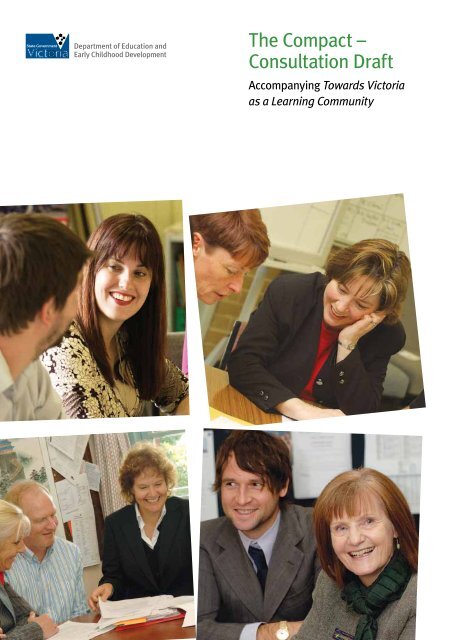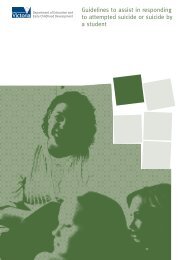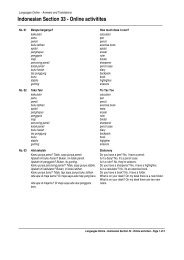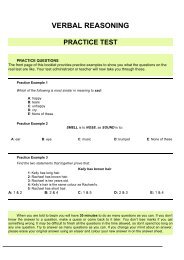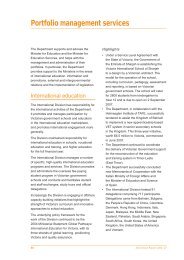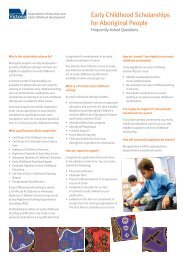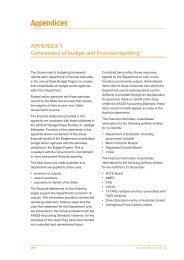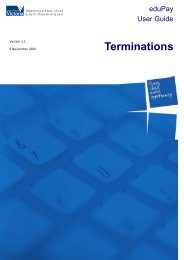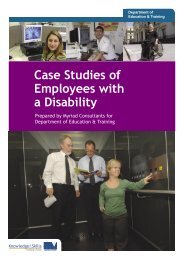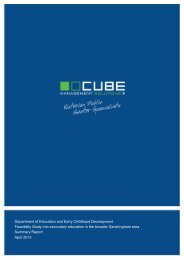The Compact â Consultation Draft - Department of Education and ...
The Compact â Consultation Draft - Department of Education and ...
The Compact â Consultation Draft - Department of Education and ...
- No tags were found...
You also want an ePaper? Increase the reach of your titles
YUMPU automatically turns print PDFs into web optimized ePapers that Google loves.
<strong>The</strong> <strong>Compact</strong> –<strong>Consultation</strong> <strong>Draft</strong>Accompanying Towards Victoriaas a Learning Community
ContentsMinister’s Message 1Introduction 21. Improving school leadership <strong>and</strong> teacher 4quality is how Victoria will become top tierPr<strong>of</strong>essional Practice 4NEED YOURPUBLISHINGDETAILSHERE2. Schools have the responsibility for transforming 7teaching <strong>and</strong> improving student outcomesCurriculum, assessment <strong>and</strong> reporting 7Curriculum 7Assessment 9Assessment 93. Accountability for outcomes 104. Supporting schools 135. Partnerships across the learning community 16Published Published by byCommunications Published by Division the Communications Division for Flagshipfor the Strategies Strategy Division & Review Group<strong>Department</strong> <strong>Department</strong> <strong>of</strong> <strong>Education</strong> <strong>of</strong> <strong>Education</strong> & Early & Early Childhood Childhood DevelopmentLevel Level 3, 33 3, St 33 Andrews St Andrews Place PlaceMelbourne Melbourne VIC 3001 VIC 30016. Next steps 17Melbourne MelbourneSeptember November 2012 2012© State © State <strong>of</strong> Victoria <strong>of</strong> Victoria (<strong>Department</strong> (<strong>Department</strong> <strong>of</strong> <strong>Education</strong> <strong>of</strong> <strong>Education</strong><strong>and</strong> Early <strong>and</strong> Early Childhood Childhood Development) 2012 2012<strong>The</strong> copyright in this document is ownedis by owned the State by the <strong>of</strong> Victoria State <strong>of</strong> (<strong>Department</strong>Victoria(<strong>Department</strong> <strong>of</strong> <strong>Education</strong> <strong>and</strong> <strong>of</strong> <strong>Education</strong> Early Childhood <strong>and</strong> EarlyChildhood Development), Development), or in the case or in <strong>of</strong> the somecase materials, <strong>of</strong> some by materials, third parties by (third partyparties materials). (third party No materials). part may be No reproduced part may be by reproducedany processby any except process in accordance except in accordance with the provisions with the provisions <strong>of</strong> the Copyright<strong>of</strong> the Act Copyright 1968, the Act National 1968, the <strong>Education</strong> National Access <strong>Education</strong> Licence forAccess Schools Licence (NEALS) for Schools (see (NEALS) below) or (see with below) permission. or withpermission. An educational institution situated in Australia whichAn educational is not conducted institution for pr<strong>of</strong>it, situated or a in body Australia responsible whichis not for conducted administering for pr<strong>of</strong>it, such or an a body institution responsible may copy <strong>and</strong>for administering communicate such the materials, an institution other may than copy third <strong>and</strong> partycommunicate materials, the for materials, the educational other than purposes third party <strong>of</strong> the institution.materials, for the educational purposes <strong>of</strong> the institution.Authorised by the <strong>Department</strong> <strong>of</strong> <strong>Education</strong>Authorised <strong>and</strong> Early by the Childhood <strong>Department</strong> Development, <strong>of</strong> <strong>Education</strong><strong>and</strong> Early 2 Treasury Childhood Place, Development,East Melbourne, Victoria, 3002.2 Treasury Place, East Melbourne, Victoria, 3002.ISBN 978-0-7594-0709-1ISBN xxxxxx1 <strong>The</strong> <strong>Compact</strong> – <strong>Consultation</strong> <strong>Draft</strong>
<strong>The</strong> responsibilities <strong>of</strong> schools <strong>and</strong> the <strong>Department</strong> relatingto each principle are outlined in the following pages. <strong>The</strong>broader application <strong>of</strong> these principles should be informedby each school’s vision, values <strong>and</strong> strategic planning. <strong>The</strong><strong>Compact</strong> will be updated regularly <strong>and</strong> through consultationto reflect future changes to autonomy.Changing RelationshipsIncreased pr<strong>of</strong>essional trust <strong>and</strong> autonomy for schools willresult in fewer m<strong>and</strong>ates <strong>and</strong> more targeted <strong>and</strong> responsivesupport from the <strong>Department</strong>. <strong>The</strong>se changes will mean thatprincipals are expected to exercise their responsibility fordriving improvement at the local level.In this context, schools will be expected to:• act in the best interests <strong>of</strong> their students, families, localcommunities <strong>and</strong> peers being accountable to them foroutcomes, performance <strong>and</strong> improvement• actively <strong>and</strong> positively contribute to the educationsystem, for the broader benefit <strong>of</strong> all Victorian students• engage with local government, relevant communityorganisations <strong>and</strong> other providers, including the EarlyChildhood, Higher <strong>Education</strong> <strong>and</strong> Skills sectors.<strong>The</strong> <strong>Department</strong> will retain its obligation to intervene toenhance student outcomes where performance measuresclearly indicate that a school is not performing effectively,<strong>and</strong> support from the <strong>Department</strong> has been unable toaddress this.• work collaboratively <strong>and</strong> in partnership with otherschools, business <strong>and</strong> industryAccountability Requirements<strong>The</strong> <strong>Compact</strong> aims to empower schools to deliver theircore responsibilities in a locally relevant way. It does notreplace or remove any existing accountability arrangementsoutlined below.Schools are required to refer to <strong>and</strong> meetthe obligations:• Current legislative <strong>and</strong> regulatory requirements<strong>and</strong> guidelines (including, but not limited to, thosecreated under: <strong>Education</strong> <strong>and</strong> Training Reform Act2006; Equal Opportunity Act 2010; Fair Work Act2009; Financial Management Act 1994; OccupationalHealth <strong>and</strong> Safety Act 2004; Accident CompensationAct 1985; Public Administration Act 2004 <strong>and</strong> theConstitution Act 1975)• VRQA minimum st<strong>and</strong>ards• ACARA <strong>and</strong> VCAA curriculum guidelines <strong>and</strong>m<strong>and</strong>ated policies• School council responsibilities outlined in theCouncil Constituting Order <strong>of</strong> individual schools<strong>and</strong> the induction section <strong>of</strong> the Improving SchoolGovernance h<strong>and</strong>book• Principals Guide to School Council Elections• Commonwealth <strong>and</strong> Victorian policy requirementsincluding National <strong>Education</strong> Agreement <strong>and</strong>National Partnership Agreements in which Victoria isa participant• School Accountability <strong>and</strong> Improvement Framework(currently under revision, to be replaced by SchoolPerformance Framework)• Student Engagement Policy Guidelines• DEECD Human Resources website• Schools Policy <strong>and</strong> Advisory Guide• Student Resource Package Guide• Out <strong>of</strong> Home Care <strong>Education</strong> Commitment 2011• Victorian Institute <strong>of</strong> Teaching requirements• Enterprise Bargaining Agreements• Principal contract accountabilities (ScheduleB), including performance management <strong>and</strong>development processes2<strong>The</strong> <strong>Compact</strong> – <strong>Consultation</strong> <strong>Draft</strong>
Principles <strong>and</strong> responsibilitiesPrinciple 1:All students can exercise educationchoices that meet their learningneeds, aspirations <strong>and</strong> interests,<strong>and</strong> will be supported to reachtheir full potentialAim• Provide teaching <strong>and</strong> learning programs, <strong>and</strong>implement practices <strong>and</strong> resources, which allow youngVictorians to fully participate in education.• Develop the skills <strong>and</strong> abilities that will prepare allstudents, including vulnerable students <strong>and</strong> studentswith disabilities, for lifelong learning <strong>and</strong> success intheir chosen post-school pathway.ResponsibilitiesSchools will:• Provide equitable enrolment opportunities to all localstudents (subject to admission criteria policies definedby the <strong>Department</strong>).• Plan, document, implement <strong>and</strong> publish anexplicit, school-wide curriculum that providescore requirements (e.g. AusVELS, VCE, VCAL,VETiS; supports student choice, empowerment<strong>and</strong> engagement (e.g. through locally determinedspecialisations); reflects community priorities; <strong>and</strong>prepares students for life in the 21st century.• Develop or adopt an evidence-based instructionalmodel <strong>and</strong> ensure its use across the school.• Ensure a range <strong>of</strong> assessment practices are used tomonitor <strong>and</strong> evaluate each student’s progress, guideinstructional practice, identify learning <strong>and</strong> studentpathways, <strong>and</strong> report to students <strong>and</strong> families onprogress.• Establish networks <strong>and</strong> partnerships with otherschools, early childhood <strong>and</strong> further educationsettings, <strong>and</strong> community organisations, business <strong>and</strong>industry to support student outcomes, strengthenstudent transitions <strong>and</strong> increase choice <strong>and</strong>customisation <strong>of</strong> <strong>of</strong>ferings in local areas.• Provide all students <strong>and</strong> families with the skills,information <strong>and</strong> support they need to make informeddecisions about options <strong>and</strong> pathways through school<strong>and</strong> post school.<strong>The</strong> <strong>Department</strong> will:• Provide schools with admission criteria policiesto support school enrolments <strong>and</strong> develop thesecollaboratively with schools where differentiatedpolicies are required (e.g. specialisation).• Provide evidence-based, validated curriculum,assessment, <strong>and</strong> instructional model resources.• Facilitate <strong>and</strong> broker networks <strong>and</strong> partnerships whereschools require additional support to form these.• Provide guidance <strong>and</strong> processes to support positivetransition from kindergarten to school.• Provide guidance <strong>and</strong> processes for effective studentpathways <strong>and</strong> exit processes into further education,training <strong>and</strong> employment for all students.• Ensure access to targeted <strong>and</strong> comprehensive supportfor schools facing exceptional challenges withoperational or curriculum planning.<strong>The</strong> <strong>Compact</strong> – <strong>Consultation</strong> <strong>Draft</strong> 3
Principle 3:Schools provide inclusive, safe<strong>and</strong> orderly environments for allmembers <strong>of</strong> the school communityAim• Support the engagement <strong>and</strong> wellbeing <strong>of</strong> all staff <strong>and</strong>students, including vulnerable students <strong>and</strong> studentswith disabilities, by providing a climate <strong>of</strong> fairness,trust <strong>and</strong> mutual respect.ResponsibilitiesSchools will:• Demonstrate sustained improvement in studentengagement <strong>and</strong> wellbeing.• Create an inclusive <strong>and</strong> respectful environment, takingaccount <strong>of</strong> the physical, intellectual, cultural, moral<strong>and</strong> social needs <strong>of</strong> students, families <strong>and</strong> carers.• Build partnerships in local areas to maximise studentinclusion, engagement <strong>and</strong> re-engagement in highquality learning experiences.• Document, communicate <strong>and</strong> implement schoolpolicies <strong>and</strong> strategies relating to student safety,wellbeing <strong>and</strong> engagement, including addressingdiscrimination <strong>and</strong> the impact <strong>of</strong> disadvantage, <strong>and</strong>supporting students facing complex challenges.• Ensure student consultation <strong>and</strong> voice in thedevelopment <strong>of</strong> policies that contribute to providing aninclusive, supportive <strong>and</strong> orderly school environment.• Establish clear policies <strong>and</strong> strategies to managechallenging behaviour, including appropriatepr<strong>of</strong>essional learning for teachers, the development<strong>of</strong> curriculum experiences to meet the needs <strong>of</strong> allstudents, <strong>and</strong> the development <strong>and</strong> communication <strong>of</strong>student referral processes for rare instances when theneeds <strong>of</strong> the student cannot be met within the school.• Apply appropriate discipline <strong>and</strong> behaviourprocedures, including suspension <strong>and</strong> expulsion, inline with system level policies, recognising the needto ensure that all young people have an appropriatepathway in education.• Provide school health programs that build life skills <strong>and</strong>resilience <strong>and</strong> promote general health <strong>and</strong> wellbeing.• Ensure that a duty <strong>of</strong> care is provided to all studentsenrolled at the school for all school programs.• Report data on suspensions, expulsions <strong>and</strong> thenumber <strong>of</strong> students that move to different settings.<strong>The</strong> <strong>Department</strong> will:• Provide practical guidance <strong>and</strong> resources for managingchallenging behaviour, bullying, discipline, cybersafety<strong>and</strong> wellbeing.• Ensure access to pr<strong>of</strong>essional learning relating tostudent welfare <strong>and</strong> discipline, <strong>and</strong> access to specialistexpertise in exceptional, complex cases.• Broker partnerships with youth, community <strong>and</strong> healthservices where a school is facing particular challenges<strong>and</strong> needs support.• Ensure access to resources, strategies <strong>and</strong> approachesrelating to student safety, wellbeing <strong>and</strong> engagement,including addressing discrimination <strong>and</strong> the impact <strong>of</strong>disadvantage, <strong>and</strong> supporting students facing complexchallenges.• Conduct research <strong>and</strong> identify best practice in relationto optimal school environments.• Provide quality assured surveys for staff, students<strong>and</strong> parents so that schools can assess engagement,wellbeing <strong>and</strong> safety <strong>of</strong> staff <strong>and</strong> students, <strong>and</strong> thegeneral climate <strong>of</strong> the school.<strong>The</strong> <strong>Compact</strong> – <strong>Consultation</strong> <strong>Draft</strong> 5
Principle 4:Resources are managed effectively,efficiently <strong>and</strong> fairly to deliver thebest possible education experiences<strong>and</strong> outcomes for all studentsAim• Plan, allocate <strong>and</strong> share resources in ways that usethem to the greatest effect, <strong>and</strong> that demonstratevalue, equity <strong>and</strong> responsiveness to local needs.ResponsibilitiesWorkforceSchools will:• Attract <strong>and</strong> retain 39a high quality school workforce,ensuring clear role expectations <strong>and</strong> flexiblemanagement <strong>of</strong> workload <strong>and</strong> deployment, to achieveschool strategic aims <strong>and</strong> goals.• Conduct principal selection processes that supportselection <strong>of</strong> the right c<strong>and</strong>idate to drive schoolperformance <strong>and</strong> represent the needs <strong>and</strong> expectations<strong>of</strong> the school community.• Organise high-performing teachers to support otherstaff (e.g. through peer observation <strong>and</strong> coaching),develop best practice models, <strong>and</strong> lead pr<strong>of</strong>essionaldevelopment.• Demonstrate proactive <strong>and</strong> robust management <strong>of</strong>staff performance, including capacity-building <strong>and</strong>evidence-based progression against agreed targets.• Include student feedback in workforce planning <strong>and</strong>development, (e.g. student survey data on teacherperformance).• Regularly review, adapt <strong>and</strong> improve school workforcemanagement practices, including practices related tothe maintenance <strong>and</strong> enhancement <strong>of</strong> staff wellbeing.• Focus on performance <strong>and</strong> capacity-building <strong>of</strong> all staff(e.g. teachers, support staff, specialists), recognisinggood performance <strong>and</strong> taking appropriate action whenstaff are underperforming.• Ensure an appropriate level <strong>of</strong> staff input into schoolpolicy, through the use <strong>of</strong> open <strong>and</strong> consultativedecision making processes.• Comply with National Employment St<strong>and</strong>ards,legislative requirements, <strong>and</strong> the principles <strong>of</strong>employment <strong>and</strong> conduct that apply in the publicsector (e.g. merit-based selection, equal opportunity,dispute resolution).<strong>The</strong> <strong>Department</strong> will:• Provide guidance <strong>and</strong> resources that support the fullHR management lifecycle (recruitment, selection,performance management <strong>and</strong> recognition, exitprocedures).• Provide workforce planning data <strong>and</strong> analysis tosupport schools in the management <strong>and</strong> development<strong>of</strong> their own workforce.• Develop <strong>and</strong> implement programs <strong>and</strong> initiatives toincrease supply <strong>of</strong> high quality entrants into teaching,particularly where shortages exist.• Implement a defined principal performancemanagement cycle <strong>and</strong> accompanying processes.• Provide access to specialist expertise <strong>and</strong> support forschools facing exceptionally challenging workforceissues.• Provide advice in relation to school management <strong>of</strong>payroll <strong>and</strong> leave functions.6<strong>The</strong> <strong>Compact</strong> – <strong>Consultation</strong> <strong>Draft</strong>• Ensure support for new, acting <strong>and</strong> transitioningprincipals.
FundingSchools will:• Demonstrate equity <strong>and</strong> transparency in the use<strong>of</strong> funding <strong>and</strong> resources, including appropriatecommunication <strong>and</strong> decision making processes relatedto the partnership role <strong>of</strong> the principal <strong>and</strong> schoolcouncil <strong>and</strong> appropriate governance <strong>and</strong> controls overfinancial assets.• Ensure that the interests <strong>and</strong> needs <strong>of</strong> students areparamount when making decisions regarding thepurchase <strong>of</strong> programs from external providers.• Ensure that any arrangements a school enters into witheducation <strong>and</strong> training providers to provide all or part<strong>of</strong> a school program are consistent with departmentalpolicies <strong>and</strong> guidelines <strong>and</strong> represent value for moneyin the use <strong>of</strong> government funds.• Allocate resources <strong>and</strong> monitor efficiency in order toachieve strategic plan targets <strong>and</strong> ensure the sustainedoperation <strong>and</strong> financial independence <strong>of</strong> the school.• Ensure the budget is aligned <strong>and</strong> integrated withlearning priorities.<strong>The</strong> <strong>Department</strong> will:• Undertake fair, appropriate <strong>and</strong> transparent allocation<strong>of</strong> all Commonwealth <strong>and</strong> Victorian governmentfunding.• Provide an inclusive Student Resource Package (SRP)that maximises discretionary funding.• Provide clear processes for accessing centrallymanagedsources <strong>of</strong> funding outside the SRP (e.g.workforce bridging, capital funding).• Provide technical <strong>and</strong> policy advice, pr<strong>of</strong>essionaldevelopment, guidance <strong>and</strong> benchmarking on financialmanagement <strong>and</strong> procurement.• Monitor high-risk school-level expenditure (defined byvolume <strong>and</strong> value).• Facilitate larger-scale partnerships <strong>and</strong> shared servicearrangements that reduce administrative costs oroverheads (e.g. Local Administration Bureaus).• Provide appropriate advice <strong>and</strong> support on the role <strong>of</strong>the school council.• Choose suppliers, <strong>and</strong> opt in <strong>and</strong> out <strong>of</strong> <strong>Department</strong>’sservice provision as best meets local needs.InfrastructureSchools will:• Maintain safe <strong>and</strong> secure environments, includingmeeting regulatory requirements.• Align infrastructure planning <strong>and</strong> management withschool strategic planning, ensuring appropriate inputfrom the school council.• Opt in to the model for capital works management thatmeets the capacity <strong>of</strong> the school <strong>and</strong> correspondingsupport needed from the <strong>Department</strong>.• Maintain ICT systems, data storage (including CASES21) <strong>and</strong> transfer processes that support school, region<strong>and</strong> system-wide monitoring, reporting <strong>and</strong> studenttransitions.• Seek opportunities to share sites, facilities <strong>and</strong> ICTsystems with early childhood providers, communitylearning organisations, local government <strong>and</strong> otherschools.<strong>The</strong> <strong>Department</strong> will:• Strategically manage its portfolio <strong>of</strong> infrastructure,including demographic, provision <strong>and</strong> capacityplanning.• Provide capital works project management <strong>and</strong>support, at the level requested by individual schools.• Undertake targeted investment for maintenanceprojects, in line with audit priorities.• Monitor maintenance requirements through conditionassessments.• Provide access to a central internet service provider.• Broker partnership arrangements that support localplanning, development, sharing <strong>and</strong> maintenance <strong>of</strong>infrastructure <strong>and</strong> ICT.• Provide appropriate advice <strong>and</strong> support on the role <strong>of</strong>the school council.• Undertake a sustainable, transparent <strong>and</strong> needs basedapproach to asset management <strong>and</strong> investment.<strong>The</strong> <strong>Compact</strong> – <strong>Consultation</strong> <strong>Draft</strong> 7
Principle 5:Schools <strong>and</strong> the <strong>Department</strong>are open <strong>and</strong> responsive toschool communities <strong>and</strong> are heldaccountable for outcomesAim• Work together to promote <strong>and</strong> build public confidencein government schools by consulting <strong>and</strong> reporting onactivities <strong>and</strong> achievements.• Engage the active participation <strong>and</strong> support <strong>of</strong> families,businesses, <strong>and</strong> local communities; promote feedback<strong>and</strong> dialogue; <strong>and</strong> foster innovation <strong>and</strong> best practiceacross the system.• Be accountable for working within the legislative <strong>and</strong>regulatory framework for Victorian government schools,while exercising flexibilities to meet the needs <strong>of</strong>students <strong>and</strong> the expectations <strong>of</strong> local communities.ResponsibilitiesSchools will:• Implement planning, monitoring, <strong>and</strong> reviewingprocesses (including developing a Strategic Plan <strong>and</strong>engaging in periodic reviews) that support schoolimprovement.• Report these dimensions <strong>of</strong> performance regularly<strong>and</strong> in plain English to the school council, schoolcommunity <strong>and</strong> the <strong>Department</strong>.• Report regularly to families <strong>and</strong> students on studentachievement, progress <strong>and</strong> plans for improved learning.• Administer system-wide surveys <strong>and</strong> data collection(e.g. staff, student <strong>and</strong> parent surveys), <strong>and</strong> participatein core national <strong>and</strong> international assessmentprograms (e.g. NAPLAN, PISA, TIMSS, PIRLS).• Provide the <strong>Department</strong> with quality student <strong>and</strong>school level data (including student attendance,assessment <strong>and</strong> destination survey data) in a timely<strong>and</strong> accurate manner.• Operate locally-appropriate governance models <strong>and</strong>processes that engage the school council, families/carers <strong>and</strong> the community as active participants ineducation <strong>and</strong> development.<strong>The</strong> <strong>Department</strong> will:• Provide governance <strong>and</strong> policy frameworks that areconsistent with legislated responsibilities <strong>of</strong> schools/school councils <strong>and</strong> which support local flexibility <strong>and</strong>decision-making.• Implement guidance <strong>and</strong> capacity building forschool councillors, <strong>and</strong> support <strong>and</strong> intervene wheresignificant failures <strong>of</strong> governance arrangements occur.• Provide timely, accurate <strong>and</strong> functional performancedata that enables school-level benchmarking, <strong>and</strong>which provides feedback from system surveys <strong>and</strong>sample assessments.• Provide access to core performance indicators,transparent performance st<strong>and</strong>ards for schools, <strong>and</strong>clear expectations/triggers <strong>of</strong> graduated support <strong>and</strong>intervention.• Monitor school performance against a range <strong>of</strong>core indicators, <strong>and</strong> provide targeted responses todemonstrated issues related to school performance<strong>and</strong> student outcomes.• Maintain a pool <strong>of</strong> trained <strong>and</strong> accredited schoolreviewers (including practising principals), <strong>and</strong> provideguidance <strong>and</strong> resources for school review activities.8<strong>The</strong> <strong>Compact</strong> – <strong>Consultation</strong> <strong>Draft</strong>


